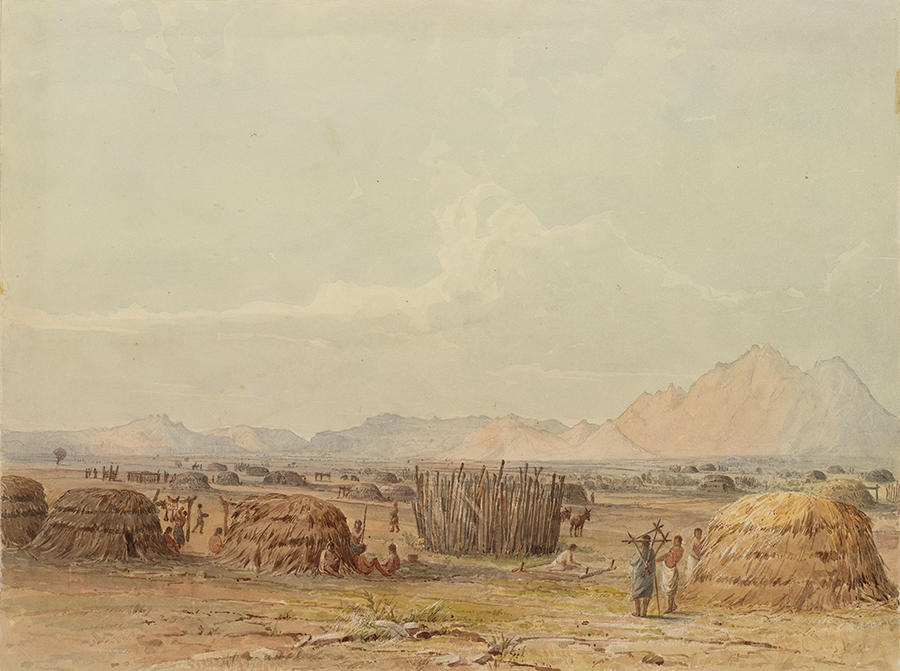
In the middle of the nineteenth century, travelers completing the rugged jornada north of Tucson were often surprised to find a city scattered for twenty miles along the banks of the Gila River, above its junction with the Salt and the Santa Cruz. At that natural crossroads, strings of family rancherías gathered in clusters to form ten villages with a collective population of around four thousand. The Pima-Maricopa Villages comprised one of the largest settlements on the Gila Trail, five times the size of Tucson or Yuma, and twice the size of Mesilla. It was both a stronghold and a model of husbandry and commerce.
Eighty-nine percent of the community declared themselves Pimas or Akimel O’odham, a Uto-Aztecan speaking people, when interviewed in 1860. These River People, as they called themselves, were cousins of the Tohono O’odham, the Desert People found south of Picacho Peak. The balance of the Gila River Villagers were Yuman-speaking Maricopa, Cocomaricopa, and other Halchidhoma who had earlier fled Quecha and Mohave adversaries on the Colorado. Alongside the Pima on the Gila River, the Yuman-speakers enjoyed amity and comparative peace. Their alliance was strategic as well as fraternal: fresh recruits not only brought their martial skills and experience to the Pima army — which was critical in their defense against Western Apache and Yavapai raids and assaults, but their village served as a buffer zone on the Pima’s western flank. In return, the Maricopa could count on the formidable Gila Villages army to join their defense when hostile Colorado River bands attacked.
An 1860 accounting found the Gila River Villages’ 763 farmers harvested 13,380 tons of corn and wheat, 240 tons of beans, 4.6 tons of cotton and 2.5 of tobacco, and raised seven hundred oxen and cattle on 7,291 acres of cultivated land that year. The women additionally gathered and processed 1,950 gallons of saguaro preserves. Some visitors found garlands of Apache ears hanging from the ramadas where trade was conducted, as vendors might display documents proving a duty had been paid to do business. The confederated Gila River tribes would form a security alliance with the Americans, as they had with the Spaniards and Mexicans, to defend against raids and assaults.
Notes: Boundary survey illustrator Henry Pratt made a field drawing of the Gila River Villages when he passed through, titled “Maricopa, the Pima winter village on the River Gila.” Artist Seth Eastman, a West Point alumnus and an officer, animated it with this 9×12-inch watercolor. Like his other renderings of boundary survey sketches, it was meant for the second volume of Bartlett but excluded due to budget limits. https://risdmuseum.org/art-design/collection/village-pimo-indians-river-gila-4711211. John Russell Bartlett, Personal Narrative of Explorations and Incidents in Texas, New Mexico, California, Sonora, and Chihuahua . . . 2 vols. (New York: D. Appleton & Co., 1854), 2:202-204, 215, 232, 234, 249. John P. Wilson, Peoples of the Middle Gila: A Documentary History of the Pimas and Maricopas, 1500’s-1945 (Las Cruces, New Mexico: The Gila River Indian Community, 1998), 7-8, 9, 12, 34, 113. N. Michler, From the 111th Meridian of Longitude to the Pacific Ocean, 106. In United States Congress. Senate. 1857. Report on the United States and Mexican Boundary Survey, Volume I Part I, 34th Congress 1st Session, Senate Exec. Doc. No. 108 Serial 861 (Washington, D. C.: A. O. P. Nicholson, printer, 1857), 102, 112, 117; and C. C. Parry and Arthur Schott, Geological Reports, in Volume I Part II, 20. David H. DeJong, “The Granary of Arizona: The Civil War, Settlers, and Pima-Maricopa Agriculture, 1860-1869,” Journal of Arizona History 48, no. 3 (Autumn 2007): 223-24. Teodoro Ramírez to Rafael Elías González, Interim Governor of Sonora, Tucson, September 6, 1837; In A Frontier Documentary: Sonora and Tucson, 1821-1848, ed. Kieran McCarty (Tucson: University of Arizona Press, 1997), 55-56. Five Pima calendar-stick readers recounted sixty-six intertribal battles or skirmishes in the seven decades between 1833 and 1902. But early twentieth-century ethnologist Frank Russell estimated that small Apache raiding parties historically preyed on the Pima Villages as frequently as twice a week, taking livestock and killing vulnerable individuals on the outskirts of the rancherías, and more substantial Apache war parties attacked as often as once a month. By mid-century, thought Russell, these circumstances forced the concentration of the rancherías on the Gila Plain west of Sacaton, and the constant vigilance of armed pickets. Frank Russell, The Pima Indians (Tucson: University of Arizona Press, 1975), 35, 37, 200-201. For a comprehensive review of primitive Maricopa irrigation techniques, see Leslie Spier, Yuman Tribes of the Gila River (1933; unabridged republication, New York: Dover Publications, 1978), 48-50, 58-65. For a study of the final confrontation between Colorado River tribes and the Gila Villages forces, the Battle of Maricopa Wells, see Clifton B. Kroeber and Bernard L. Fontana, Massacre on the Gila (Tucson: University of Arizona Press, 1986).